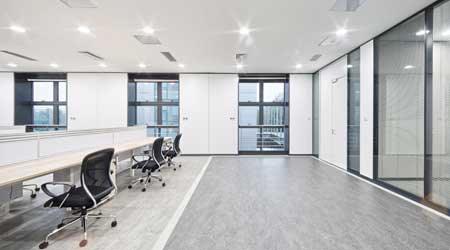 The acoustical quality of an open workplace is shaped by a wide range of building elements, including the type of ceiling, whether sound masking is being used, the type of partitions between workstations, if any, and how much exposed hard surface area there is.
The acoustical quality of an open workplace is shaped by a wide range of building elements, including the type of ceiling, whether sound masking is being used, the type of partitions between workstations, if any, and how much exposed hard surface area there is.Movable Wall Systems Can Improve Acoustics, Protect Privacy
The flexibility of movable wall systems can solve acoustical issues in a space by giving occupants more options for where and how to work.
Distraction in the workplace has negative effects on cognition, and for this reason, it is important to maintain speech privacy and prevent noise distraction, says David Patton, vice president of product design at Vari.
The deep work — or deep thinking — necessary in the workplace cannot get done without properly addressing acoustical issues, which can result in a loss of productivity, a lack of engagement, friction among coworkers, and even depression, Patton says.
Moveable wall systems, which are being used more frequently in a variety of workplaces, can play an important role in establishing speech privacy and speech intelligibility in shared spaces.
“Operable partitions give people flexibility in how they use their space,” says Bryan Welch, managing director of Modernfold.
In creating temporary work areas, people want both space and sound separation, and people inside these spaces want “the same confidence in acoustical control and privacy.” Thus, the makers of wall systems must provide products that give “performance comparable to a fixed wall,” says Welch.
Moveable walls address a range of functional issues beyond acoustics.
A trend Welch is seeing with movable walls is the use of more glass, because of the emphasis on meeting LEED standards and the desire for more daylighting. Where windows are accessible, a glass partition may be used to allow light to come deeper into space, but still allow for speech privacy.
Ease of operation can be an important benefit of movable walls, and fully automated products that operate with the touch of a button are available. While such products cost more money, they are valuable in the modern workplace, where maintenance personnel may not be available to set up and move things around. Often, employees are operating these walls, Welch says, and they won’t use them unless they are easy to operate.
Flexibility is another potential benefit. Businesses often begin with one space model, but over time the business grows and the space configuration has to change. Walls that are easy to put up and take down accommodate a changing environment.
“A tool-free design means you can rapidly move sections around and expand, contract, and reconfigure,” Patton says.
Maryellen Lo Bosco is a freelance writer who covers facility management and technology. She is a contributing editor for Building Operating Management.
Related Topics:














